Was Jimi Hendrix murdered? (November 27, 1942 – September 18, 1970)
Over the past five decades, much has come to light suggesting Hendrix's death was foul play, although the media erroneously reported it as a drug overdose.
Watch full video on Twitter.
View most updated version of this post on Substack.
James Marshall “Jimi” Hendrix, the visionary who changed our world with his music, was found dead in a London flat on September 18, 1970.
As leader of the Jimi Hendrix Experience, Hendrix was the biggest solo rock star of his era. He mixed blues, R&B, soul, funk, and psychedelic rock into an intoxicating brew, topped with poetic, mystical lyrics and what most agree was the greatest guitar playing of the 1960s. Over the fifty-three years since his death, much evidence has come to light that suggests someone likely murdered Hendrix during the early morning hours of that fateful night.
His death should have been properly investigated as a possible homicide from the start. The fact that it wasn't can be chalked up to racism and indifference on the part of the British police, and a media hostile to the sixties counterculture. The press immediately ran sensationalized, erroneous headlines announcing Hendrix had O.D.'ed, when in fact he was not a junkie. The New York Times’ story published the next day stated that “Unconfirmed reports said he had died of an overdose of drugs,” which was typical of the coverage. Announcing the news on CBS, anchor Walter Cronkite similarly blamed it on an O.D.
Hendrix was acquitted of drug possession in Toronto in early December, 1969. On May 3, 1969, customs agents had seized a small amount of heroin and hashish from Jimi’s bag after the Experience landed for a concert. While getting ready for the previous night’s show at Cobo Hall in Detroit, the band had been warned a drug bust might happen the next day. The drugs found in Hendrix’s bag were not his, and he and the rest of the band believed he had been set up by unknown persons.
Two weeks after his arrest, Hendrix confided in his friend, journalist Sharon Lawrence, that “Whatever I have done...getting hooked on heroin is not one of them.” He told Lawrence he had a fear of needles and had associated with enough junkies to know he didn’t want to be one, as recounted in her 2005 book Jimi Hendrix: The Intimate Story of a Betrayed Musical Legend.
Mitch Mitchell, the Experience’s drummer, confirmed the same in his 1990 book Jimi Hendrix: Inside the Experience, writing that “Contrary to what some people have said, Jimi was never a junkie – that is he was never addicted to any drug, particularly heroin, which he tried once or twice but didn't like.”

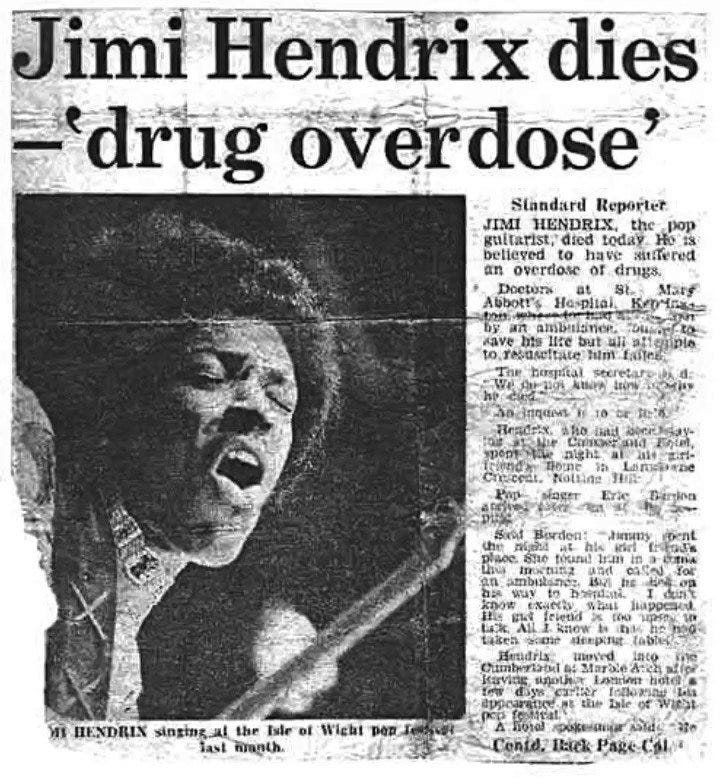

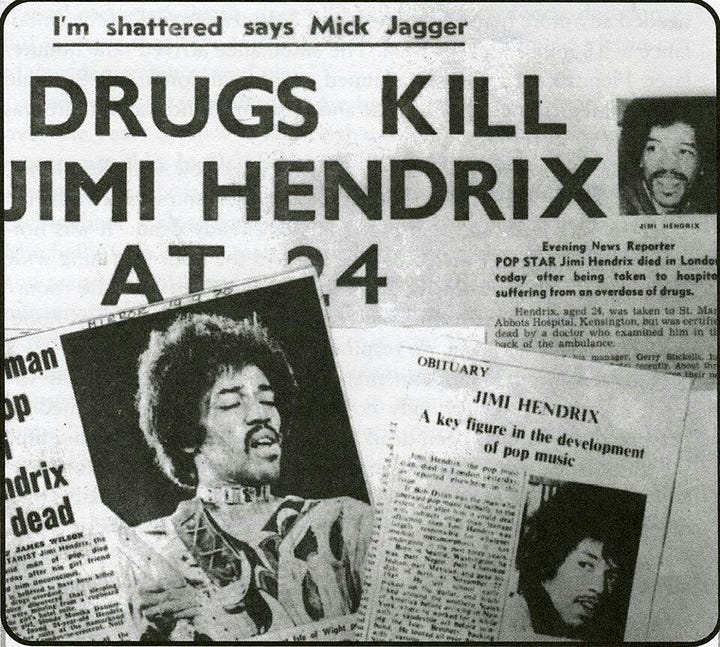
Coroner Gavin Thurston ordered a post-mortem exam, and it was performed September 21, 1970 by forensic pathologist and professor Robert Donald Teare. Completed on September 28, the inquest officially concluded Hendrix aspirated on his own vomit and died of asphyxia while intoxicated with barbiturates. Thurston declared an open verdict, citing “insufficient evidence of the circumstances,” meaning that the evidence did not fully or clearly explain the cause and circumstances of Hendrix's death and thus it could not be definitively ruled suicide, homicide, due to natural causes, or an accidental death.
The flat where his body was found was located at 22 Landsdowne Crescent in Notting Hill, London. It was actually a bohemian lodging place called the Samarkand Hotel, and Hendrix had spent the past few nights in its Garden Flat with Monika Charlotte Dannemann, a German ice skater who was 25 at the time. They had first met in Dusseldorf on January 12, 1969, but didn’t see each other again until a few days before his death, on September 15, 1970 when Dannemann checked into the Samarkand and got back in touch with Hendrix.
Hendrix with Monika Dannemann
Despite being anointed by the press as “Jimi’s final girlfriend” and efforts she made over the years to paint herself as his fiancée, Hendrix’s longtime British girlfriend Kathy Etchingham had a different view. “She was a one night stand in Germany,” Etchingham told Hendrix researcher Michael Fairchild in a 1992 interview, “and a one night stand in London, or two nights at the most.” In contrast, Etchingham met Hendrix on September 24, 1966, his very first night in London, and they continued their relationship for years. In 1969, Hendrix described Etchingham as “My girlfriend, my past girlfriend and probably my next girlfriend. My mother and sister and all that bit. My Yoko Ono from Chester.”
Hendrix with Kathy Etchingham
Dannemann was supposedly the last person to see Hendrix alive, but her account of that night changed twenty-one times over the years and its details were contradicted by all the other direct witnesses to Hendrix’s final hours. On September 24, 1970, Dannemann made the following sworn statement to authorities:
“I have known Jimi Hendrix for the past two years. I met him in Germany and we became friendly and when I came to England this year I got in contact with him and we resumed our relationship. Since Tuesday 15th September, he was living with me at my flat in Landsdowne Crescent. We went out on Wednesday and Thursday to Ronnie Scott’s Jazz Club and had a meal and a bottle of wine each evening, and spent the evenings listening to music.
On Thursday 17th September we stayed in and I cooked a meal of spaghetti and we talked until about 2 am. He then said he had to go somewhere and see some people about his band and I drove him to a house in Great Cumberland place. I asked him if I could go with him, but he said that they were not very nice people. Later about 2:45 am, I picked him up there and went home.
On our arrival I made a sandwich and we talked until about 7 am. He then said he wanted to go to sleep. He took some tablets and we went to bed. I woke up about 11 am and saw that Jimi's face was covered in vomit. I tried to wake him, but could not. I called an ambulance and he was taken to the Hospital in Kensington. He never recovered consciousness and later died at 12:45 pm. Prior to going with him to the hospital, I checked my supply of Vesperax sleeping tablets and found that 9 of them were missing. He was very happy and I never heard him talk of killing himself.”
At a party at music publisher Peter Cameron’s earlier that morning, attended by Hendrix’s new producer Alan Douglas and another of Jimi’s longtime girlfriends Devon Wilson (a party to which Dannemann was not invited), Hendrix ate some Chinese food with rice and took a Black Bomber (Durophet) amphetamine sometime between 2 and 3 am. When Dannemann arrived at 3 am to pick Hendrix up, Wilson yelled at her from the window to “leave him alone.”
Hendrix with Devon Wilson in Berkeley, California, 1970
According to Dannemann’s varying statements, they were up until 7 am either talking or arguing. Wired from the amphetamine and a chronic insomniac to begin with, Hendrix asked her if she had any sleeping pills. She offered him Vesparax, a powerful German sedative which she said she was taking to relieve the pain from an injury which had halted her ice skating career. Each tablet was twice the strength of a normal sleeping pill, and she had approximately fifty tablets in her possession.
In his 2020 book Wild Thing: The Short, Spellbinding Life of Jimi Hendrix, biographer Philip Norman noted that Hendrix's friend the folk singer Buzzy Linhart recalled on September 17, the day before his death, Hendrix claimed to have been awake for days. He then called a doctor in New York who advised him to take three times the dose of his regular sleeping pills.
The coroner’s investigation found nine tablets in Hendrix’s system. He had been reliant on sleeping pills for years and had built up a tolerance to their effects. In fact, he had tried Vesparax in the past and it hadn’t put him under. But if Hendrix took that number on the doctor’s advice because his regular dose was three sleeping pills, nine of the double-dose Vesparax would have been six times the sedative strength he was used to. The possibility Hendrix committed suicide has been discounted based on the fact there were 42 Vesparax tablets remaining, since he could have taken many more if intent on self-harm.
Although he was a notoriously light drinker, his lungs and stomach were full of what one of the ER doctors said was “a massive amount of red wine.” Dr. John Bannister was the surgical registrar on duty that morning at St Mary Abbots Hospital. After reading Harry Shapiro and Caesar Glebbeek’s 1990 book Jimi Hendrix: Electric Gypsy, Bannister wrote a letter to Shapiro about Hendrix’s condition upon arrival. “The very striking memory of this event,” he wrote, “was the considerable amount of alcohol in his larynx and pharynx…I recall vividly the large amounts of red wine that oozed from his stomach and his lungs.” Bannister was quoted in David Henderson’s 1996 edition of 'Scuse Me While I Kiss the Sky as noting the wine was “coming out of his nose and out of his mouth.”
“(It was) very vivid because you don't often see people who have drowned in their own red wine. He had something around him—whether it was a towel or a jumper—around his neck and that was saturated with red wine. His hair was matted. He was completely cold. I personally think he probably died a long time before...He was cold and he was blue.”
He was also interviewed by The Times in 2009:
“The amount of wine that was over him was just extraordinary. Not only was it saturated right through his hair and shirt, but his lungs and stomach were absolutely full of wine … We kept sucking him out and it kept surging and surging … He had really drowned in a massive amount of red wine.”
Yet Hendrix’s autopsy showed a low blood alcohol level of only 5 mg / 100 ml, the equivalent of someone Jimi’s weight consuming approximately two glasses of wine. Meaning the red wine had been introduced into him too quickly to fully enter his bloodstream. Puddles of pure red wine were also found by the ambulance attendants on Hendrix’s bed, clothing, and matted in his hair. This is inconsistent with him vomiting up the wine, since it would have been mixed with vomit. Taken together, these facts indicate the red wine may have been forcibly poured down Hendrix’s throat within an hour before his death, with some of it spilling in the process.
Danneman said she and Hendrix eventually went to bed, and woke up to find him unresponsive beside her. But instead of undressed and under the covers, the ambulance attendants found him fully clothed when they arrived at 11:27 am, lying on top of a made bed in the flat, covered in vomit and wine. Kathy Etchingham and Mitch Mitchell’s wife Dee tracked down the two-person ambulance crew in 1991 (John Saua and Reg Jones), as well as policeman Ian Smith and Dr. Martin Seifert, one of the team of three doctors who worked on Hendrix when he arrived at the hospital later that morning. He was pronounced dead at 12:45 pm, although he clearly had been gone for many hours.
Etchingham and Mitchell also had the findings from the original coroner’s report re-analyzed using the latest technology. The re-analysis revealed that based on undigested grains of rice in Hendrix’s stomach, he must have died within three hours of eating it, the meal he consumed at the party at Peter Cameron’s. This established a time of death closer to 5:00 or 5:30 am, further undermining the credibility of Dannemann’s account that they went to bed at 7 am.
Based on statements from other witnesses, a fuller picture emerged of what really happened during the morning hours before the ambulance was called at 11:18 am.
Dannemann first called her friend Alvenia Bridges who had spent the night with Eric Burdon, trying to find the number for Hendrix’s doctor. Bridges said Dannemann was hysterical, claiming Hendrix was unconscious and vomiting. She instructed her to turn Jimi over to stop him from choking, but Dannemann did not.
Harry Shapiro laid out the subsequent timeline in a 2009 article:
“When Eric Burdon asked Monika why she hadn’t called an ambulance, she said that she was scared because there were drugs in the room. So first on the scene was Eric’s roadie Terry Slater who told Kathy that he and Monika cleared out the flat, going across the road to some adjacent gardens where they buried the drugs. Meanwhile the ambulance drivers arrived to find Jimi dead and alone in the room. Following procedure they tried to resuscitate him in the ambulance, but he was clearly gone and this would explain why they were so relaxed and didn’t rush through the streets. Terry said that he and Monika viewed all this from across the street. The doctors at the hospital also tried resuscitation, but they could see it was hopeless. Jimi had been dead for hours.”
As Dannemann’s story shifted over the years, she claimed to have woken up anywhere between 9 and 11 am. But Burdon and Bridges said she called them hours earlier, at dawn. She claimed she eventually called for an ambulance, yet Burdon told Kathy Etchingham that “I think I called the ambulance.” Dannemann claimed to have been there to meet the ambulance drivers when then arrived and to have gone with them to the hospital. However, the drivers (Saua and Jones) separately gave statements that they arrived to find the doors to the flat wide open and no one there except for Jimi’s lifeless body on the bed, and Dannemann did not accompany them as they transported him to the hospital. Dr. Martin Seifert confirmed he did not see her at the hospital.
Such major inconsistencies point to Dannemann having deliberately lied about the events she witnessed that morning. Some have speculated that she left the flat at some point after giving Hendrix the Vesparax tablets, and while he was unconscious, unknown persons came in and poured several bottles of red wine down his throat. Dr. Bannister estimated that they removed a total of five bottles’ worth of red wine from Jimi’s lungs and stomach. She may have been threatened to keep her mouth shut, paid off, or both.
Hendrix outside the Garden Flat at Samarkand Hotel, September 17, 1970
During the four years between the release of the Jimi Hendrix Experience’s debut LP Are You Experienced in May, 1967 and his death in 1970, Hendrix’s music was evolving at lightning speed. For the Experience’s third and final album, the classic double LP Electric Ladyland, Hendrix wrote the epic psychedelic masterpiece “1983… (A Merman I Should Turn To Be). Kathy Etchingham was referenced in its lyrics (as “Katherina”). He first recorded a solo demo version of the song playing acoustic guitar in a New York City apartment in early March, 1968.
The Experience began recording “1983” on March 13 at New York's Sound Center Studios. Its full backing track was completed April 22 at the Record Plant with Hendrix on guitar, bass, percussion and vocals, Mitch Mitchell on drums, and Traffic’s Chris Wood on flute. Overdubs were done on May 8, and the final mix was completed at the Record Plant on June 10. Produced by Hendrix, it was co-engineered by Eddie Kramer and Record Plant co-owner Gary Kellgren. In Jimi Hendrix: Electric Gypsy, Shapiro and Glebbeek called it “Jimi's first piece of major orchestration, using the full capacities of the Record Plant's studio facilities.”
Hendrix and Mike Jeffery
If Hendrix was murdered, who did it? Much suspicion has fallen on his manager, Mike Jeffery, who had worked for British military intelligence in the past and borrowed money from the mob to finish constructing Electric Lady Studios in Greenwich Village, which he co-owned with Hendrix. Jimi was his cash cow, but his personal management contract with Hendrix was due to expire on December 1, 1970, and Hendrix was reportedly planning to seek new representation elsewhere. Buddy Miles, his drummer in the Band of Gypsys, recalled there were “numerous times he complained about his managers.” Unfortunately, word filtered back to Jeffery of Jimi’s future plans.
By the time of his death, Hendrix may have been worth more to Jeffery dead than alive. A roadie for the Animals, James “Tappy” Wright published a book in 2009 containing the explosive claim that one night in early 1973, Jeffrey had drunkenly confessed to having ordered Hendrix’s murder. Interviewed by Shapiro in 2009, Wright claimed:
“As we are talking, Mike began to get very agitated and pale. ‘I had no bloody choice, I had to do it’. ‘What are you talking about?’ ‘You know exactly what I’m talking about. It was either that or I’d be broke or dead’. All he said was he got a few of his friends – I don’t know who they were, just some villains that Mike knew from up north and it was just booze down the windpipe. Like in that film Get Carter.”
Not everyone is convinced of Jeffrey’s involvement, including Bob Levine, who headed Jeffrey’s US office in New York and was also a close friend of Wright’s. Levine told musicradar.com in 2011 that Wright privately admitted to inventing the story of Jeffrey’s supposed confession to sell his book. According to Levine, Wright told him:
“Jimi Hendrix was not murdered. The whole thing is one giant lie … I told Tappy, ‘What are you doing making up this story? So you want to sell books – why do you have to print such lies?’ And he said to me, ‘Well, who's going to challenge me? Everybody's dead, everybody's gone. Chas Chandler [Hendrix co-manager], Michael Jeffery, Mitch Mitchell [Jimi Hendrix Experience drummer], Noel Redding [Experience guitarist]… they're all gone. Nobody can challenge what I write.’”
But Levine also said Jeffery inexplicably lied to him when he called Levine at the New York office a week after Jimi’s death and claimed to have just found out about it. In reality, Jeffery was notified immediately, as confirmed by Jim Marron, a New York nightclub owner who was vacationing with Jeffrey in Spain when the call from London came on September 18. His first reaction was, “I always knew that son of a bitch would pull a quickie,” recalled Marron.
If Jeffery did plot to have Hendrix murdered, some speculate that Monika Dannemann was one of his accomplices, and deliberately gave him a lethal dose of Vesparax. Dannemann met with Jeffery shortly after Jimi’s death, and brought him a series of photos she took of Hendrix during his final days. By chance, their meeting was interrupted by the Allen aka Aleem twins, two of Jimi’s close friends from Harlem, who wrote in their memoir about what they saw that evening:
“[I saw] photos of Jimi in what seemed to be a sequential order, starting from his arrival at Monika's villa in England and ending with his dead body in her bed [...] Michael picked up a chosen handful of photos and gave a shaky explanation for having the eerie pictures on hand. He said, “Monika is a photographer, aren't these pictures incredible?” [...] As I browsed through the photographs, it seemed obvious to me that Jimi was being slowly poisoned. As I continued browsing, I came across two photos where it was clear that Jimi was in fact dead. Gruesome! Why would she - how could she take these pictures and expose them indiscriminately even before Jimi's burial? Was she there to be paid off? I had certainly seen enough for one evening and slowly slid out of the office. From that point on, I suspected that Jimi was the victim of homicide.”
Jeffery is no longer with us because he died in a freak mid-air collision on March 5, 1973 over the South of France while aboard a passenger plane flying to the UK from Mallorca, Spain. The Douglas DC-9 he was aboard was hit by a Convair Coronado and exploded, killing all 68 passengers and crew. It was determined there had been a communications failure between the aircraft and air traffic control, which allowed the Coronado’s pilot to perform an unauthorized maneuver that caused the crash. The Coronado’s wing was damaged but it landed safely without loss of life. Ominously, as Hendrix researcher and author of The Covert War Against Rock Alex Constantine noted, the crash occurred “in the midst of a French civil air traffic control strike. Military controllers were called in as a contingency replacements for the controllers.”
Hendrix’s girlfriend Devon Wilson was one of the first to suspect foul play. She returned to the States and as one researcher put it, “told everyone she possibly could that she knew Jimi Hendrix was murdered.” Wilson ended up dead herself within five months, falling from a window of the Chelsea Hotel in New York City in February, 1971 under suspicious circumstances.
Monika Dannemann supposedly committed suicide on April 5, 1996 via carbon monoxide poisoning while seated inside an idling car in her garage. It was two days after being found guilty of contempt of court for repeating a libel against Kathy Etchingham, who had sued over claims Dannemann made in her 1995 book The Inner World of Jimi Hendrix. Dannemann wrote that Etchingham was the one who introduced Hendrix to drugs, which was what killed him. She wrote the book in the aftermath of the investigation Etchingham and Dee Mitchell carried out in the early nineties which undermined everything Dannemann had claimed for two decades about Jimi’s final hours.
However, Dannemann’s husband, guitarist Uli Jon Roth of the Scorpions, was convinced she was murdered. Roth maintained that Dannemann “did not believe in suicide.”
Besides his manager potentially standing to profit from his demise, others wanted Jimi dead as well. He was a threat to the power structure in part because he was publicly sympathetic to the Black Panthers and had a huge global audience. During 1969 he played a benefit for Black Panther Party co-founder Bobby Seale and the rest of the Chicago Eight. In a January, 1969 interview with Teenset magazine, he stated:
“Get [the] Black Panthers, not to kill anybody, but to scare [federal officials]...I know it sounds like war, but that's what's gonna have to happen. It has to be a war...You come back to reality and there are some evil folks around and they want you to be passive and weak and peaceful so that they can just overtake you like jelly on bread…You have to fight fire with fire.”
At the time, the FBI’s COINTELPRO projects were in full swing, attempting to destroy the Black Panther Party by any means necessary, including assassinations. The FBI had opened a file in Hendrix in early 1969. The CIA also had files on him as part of Operation CHAOS, which initially used CIA stations around the world to report on the anti-war activities of American citizens traveling abroad. Eventually Operation CHAOS gathered files on over 7,200 Americans. In 1979, it was revealed that Hendrix had been put on the national “Security index,” a list of America’s top “subversives” who were to be rounded up and placed in detainment camps in case of an unspecified national emergency.
Hendrix’ death came as he was returning to his R&B roots. While staying in Harlem during 1969, he had become friends with twin brothers Arthur and Albert Allen, who sang on his final records, and was planning to produce their Ghetto Fighters LP. See our earlier post on Buddy Miles for more on Miles’ collaboration with Hendrix and Billy Cox in the short-lived funk rock group Band of Gypsys.
If Jimi had lived, he might have woken up on the morning of September 18 and resumed work on his planned concept album and animated film about a Black superhero called Black Gold, which could have been an epic, transformative project.
Hendrix on September 17, 1970
Several of the songs on tapes he recorded in his Greenwich Village apartment in early 1970 found their way onto some of his final studio and live recordings, but there were nine songs that remained unheard and unreleased. One of them was finally issued in 2010. Titled “Suddenly November Morning,” it came out on West Coast Seattle Boy: The Jimi Hendrix Anthology. Hendrix’ half-sister Janie claimed the rest of the Black Gold tapes would be officially released by 2020, but the world is still waiting.
Further info:
“Who Killed Jimi Hendrix?: Rock Culture, COINTELPRO and the Continuing Legacy of Guitar Greatest,” by Alex Constantine, Feral House, 2000.
“Jimi Hendrix murder theory 'plausible' says ER doctor,” by Aislinn Simpson, The Telegraph, July 20, 2009.
“Jimi Hendrix: murder, the mafia, and the multiple mysteries surrounding the death of rock's most influential guitarist,” by Harry Shapiro, Classic Rock, July, 2009.
“Shelved: Jimi Hendrix’s Black Gold Suite,” by Tom Maxwell, Longreads, July 16, 2019.
“The death of Jimi Hendrix: the unanswered questions,” by Mark Beaumont, The Independent, September 17, 2020.
#rock #blues #soul #funk #unsolvedmurders #JimiHendrix


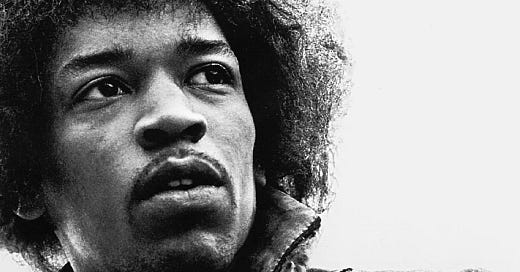

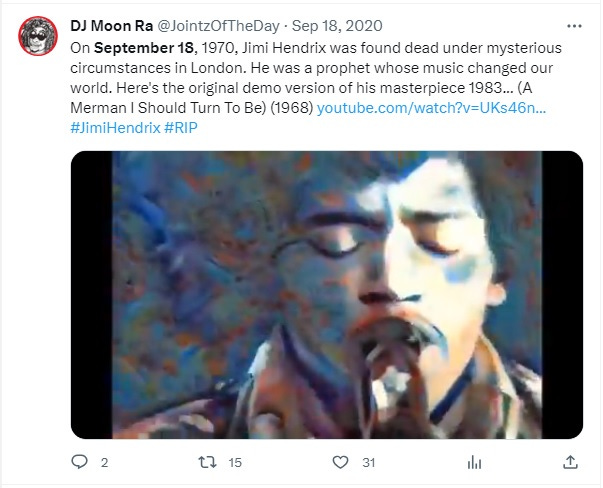
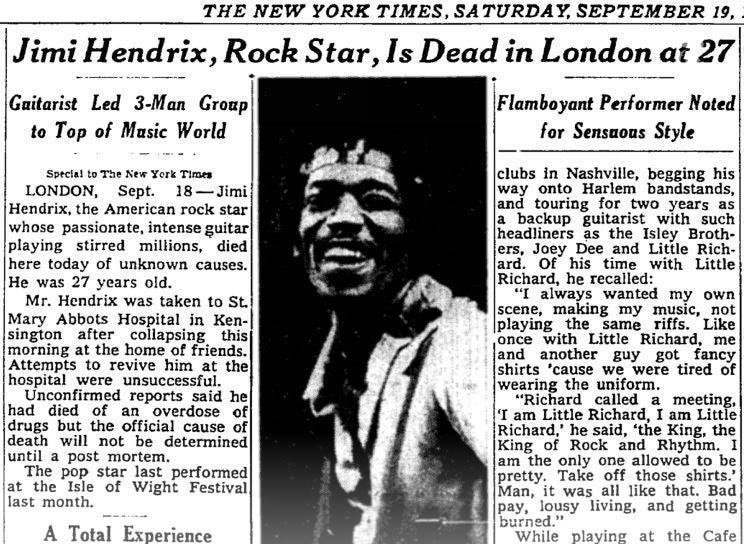



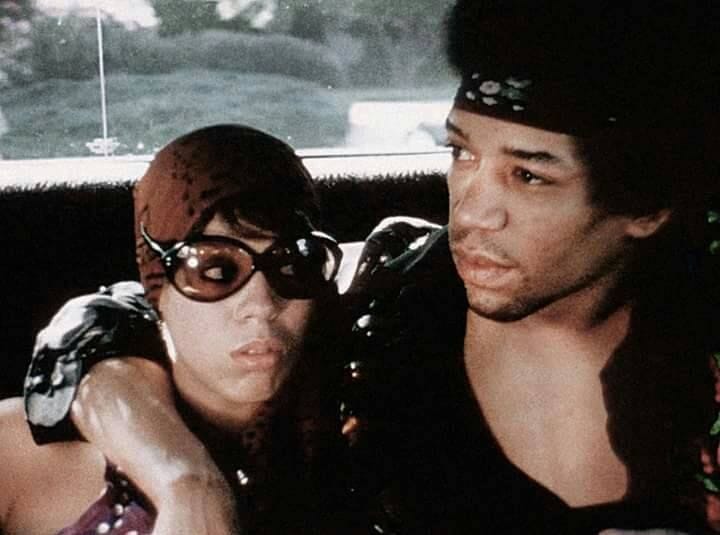
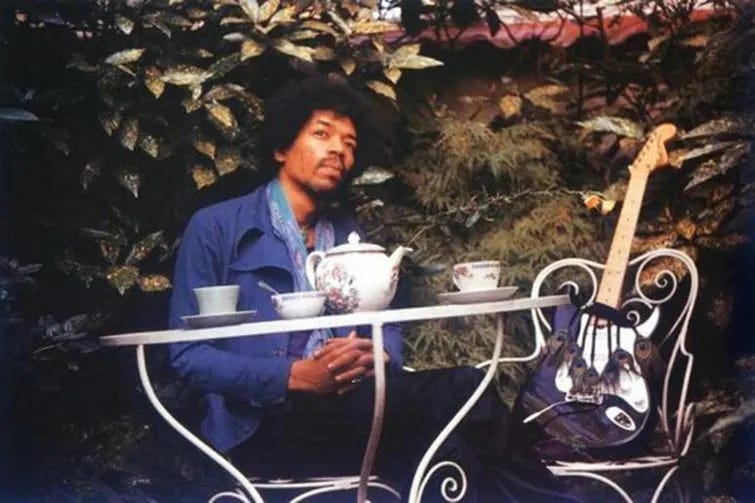
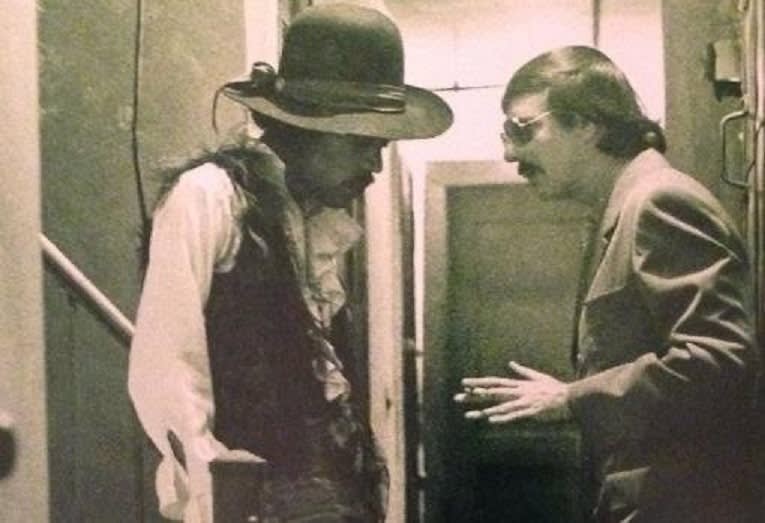
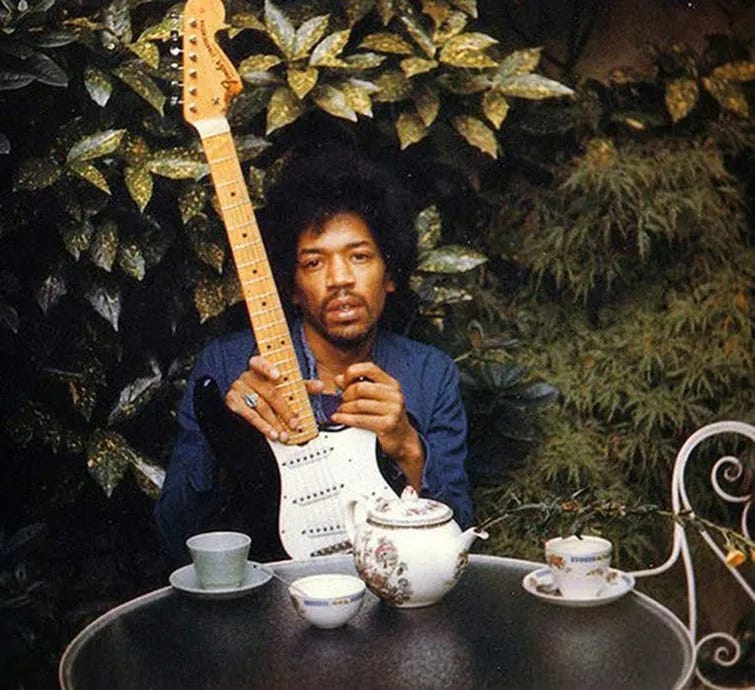
Wow. Rest In Eternal Peace Jimi.🌹 🎼 🌹
Fascinating. Thanks! I saw Hendrix at Charlotte Coliseum in the summer of 1970. Chicago opened, which is weird in retrospect - their first album hadn’t come out yet, and -- also weird -- they performed a Sgt. Pepper's medley. Hendrix was dressed all in white and played a white guitar. I had a head full of acid and one of the best evenings of my life. Hendrix was a master - he would look at his guitar while he wasn’t singing, shaking his head as though, like me, he could hardly believe what amazing music was coming out of that guitar. PBUH.